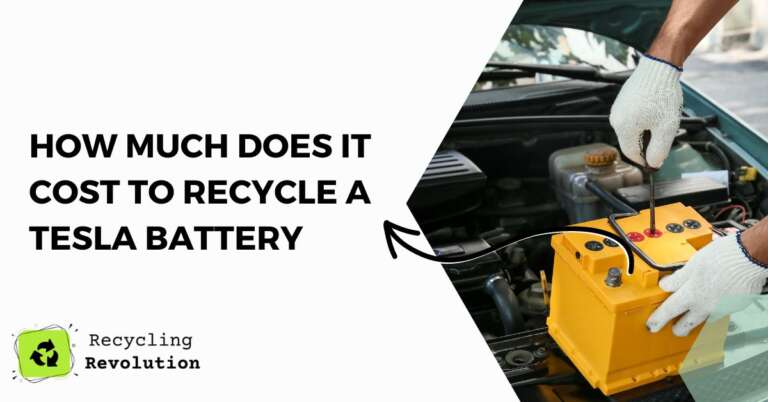Tesla is currently developing its in-house battery recycling program, which may reduce the cost substantially in the future. In general, the cost to recycle a Tesla battery can range from hundreds to thousands of dollars.
TL;DR: The cost to recycle a Tesla Battery is not straightforward as it depends on multiple factors including the model of the car, the condition of the battery, and the recycling method.
When examining the cost to recycle a Tesla battery, a number of variables come into play. First, the model of the Tesla vehicle can greatly influence the cost.
For instance, a Model 3 battery may cost less to recycle than a Model S battery due to differences in battery composition and size.
Second, the condition of the battery is a crucial determinant. If the battery is in a fairly good condition and has a significant residual capacity, it could potentially be repurposed for other applications, such as energy storage, reducing the net cost of recycling.
Finally, the recycling method chosen can also swing the costs. Different techniques carry different price tags, with some being more economical but perhaps less environmentally friendly than others. To get a better grasp on these variables, let’s dive deeper into each one.
The Model Matters
Tesla uses lithium-ion batteries in its vehicles, but the composition of these batteries can vary. For example, earlier Tesla models used a battery formulation of cobalt, aluminum, nickel, and other materials, while more recent models use a nickel-manganese-cobalt (NMC) formulation.
These differences in battery composition can influence the recycling cost. I recommend reaching out to professional battery recyclers for a quote specific to your Tesla model.
Condition is Key
The state of the battery at the time of recycling is a huge cost influencer. If the battery still holds a significant charge, it may be repurposed for other applications, such as powerwalls or grid storage. This is known as “second-life” applications and can offset some recycling costs.
If your Tesla’s battery still has substantial capacity, I recommend considering this option as a way to not only reduce the recycling cost but also contribute to a greener energy solution.
Recycling Method
Several methods are available for recycling lithium-ion batteries, including pyrometallurgical process, hydrometallurgical process, and direct recycling. Each comes with its own advantages and cost implications.
For instance, the pyrometallurgical process involves high temperatures and is less expensive but yields fewer reusable materials. Conversely, the hydrometallurgical process, although more expensive, is more environmentally friendly and recovers more materials.
Direct recycling, the method Tesla plans to implement, preserves the most materials but is currently the most expensive due to the technology involved. I recommend opting for a method that strikes a balance between cost-effectiveness and environmental impact.
Other Considerations
The Impact of Battery Age
The age of the battery is a factor we should consider in the cost of recycling a Tesla battery. Like all lithium-ion batteries, Tesla batteries degrade over time, losing their ability to hold a charge. The rate of degradation varies, depending on factors such as usage and charging habits.
A battery that is heavily used and frequently charged to its maximum capacity will degrade faster than a lightly used battery that is typically charged to around 80% capacity. The more degraded a battery is, the less potential it has for second-life applications, which can affect the overall cost of recycling.
For this reason, I recommend that Tesla owners aim to prolong the lifespan of their batteries as much as possible, which can be achieved by avoiding fully charging the battery and minimizing exposure to extreme temperatures.
Cost of Transportation
The physical process of transporting the battery to the recycling facility can also significantly impact the overall cost. Shipping a battery of such size and weight can be expensive, particularly if the recycling facility is located far from where the battery is currently.
Therefore, I recommend considering the location of the recycling facility when estimating the total cost of recycling a Tesla battery. Choosing a local facility can help cut down on these transportation costs.
Regulatory Considerations
Different regions have different regulations and standards for battery recycling. These regulations can influence the cost of recycling a battery, as facilities must follow certain procedures and safety standards.
Some regions offer incentives for recycling lithium-ion batteries, which can help offset the costs. For instance, in the European Union, the Battery Directive mandates that manufacturers are responsible for the costs of collecting, treating, and recycling all collected batteries.
In the United States, regulations vary by state, and some states offer tax incentives for battery recycling.
Changes in Raw Material Prices
The prices of the raw materials recovered from a Tesla battery can also impact the cost of recycling. Lithium, cobalt, nickel, and other materials used in Tesla batteries have significant value and can be sold to offset the cost of recycling. However, these prices can fluctuate based on supply and demand.
When there’s a high demand for these materials, the potential revenue from selling them is higher, which can reduce the net cost of recycling. Conversely, when demand is low, the potential revenue is also low, which can increase the net cost.
I recommend keeping an eye on market prices for these materials when planning to recycle a Tesla battery, as this can impact the overall cost.
Looking at Scale
The scale of operations at a recycling facility can also influence the cost. Facilities that recycle a large volume of batteries can achieve economies of scale, which can lower the cost per unit of recycling. Smaller facilities, on the other hand, may have higher costs due to less efficient operations.
Therefore, I recommend considering the size and scale of operations at the recycling facility when estimating the cost of recycling a Tesla battery. Larger facilities may offer more competitive prices.
Innovative Recycling Technologies
Emerging technologies in battery recycling could potentially bring down the cost of recycling Tesla batteries in the future. For example, new processes are being developed that can recover more materials from a battery, making the recycling process more efficient and potentially cheaper.
Research is also being conducted on methods to extend the lifespan of lithium-ion batteries and improve their performance, which could reduce the need for recycling. These advancements are something to watch for in the future.
Tesla’s In-House Recycling Program
Tesla is actively working on developing its in-house battery recycling program. This program aims to recover critical battery materials such as lithium, cobalt, nickel, and aluminum for re-use in new batteries.
The goal is to minimize waste and lower the overall cost of battery production, potentially making recycling cheaper for Tesla owners.
Note: This is a forward-looking aspect. As of now, there are no official cost estimates for Tesla’s in-house recycling process.
Additional Helpful Information
Beyond traditional recycling, there are a few alternative methods available for dealing with end-of-life Tesla batteries.
- Battery repurposing: As mentioned before, repurposing the battery for energy storage or other second-life applications can help offset the recycling cost.
- Battery refurbishment: Instead of recycling the entire battery, certain components may be refurbished and reused, reducing waste and costs.
- Trade-in programs: Some companies offer trade-in programs for used electric vehicle batteries, which can help defray the cost of recycling.
Conclusion
The cost to recycle a Tesla battery can vary significantly depending on a range of factors, from the specific model to the condition of the battery, and the chosen recycling method.
While it’s difficult to pinpoint a single dollar amount, the trend suggests that as technology improves and demand for lithium-ion battery recycling grows, costs are likely to decrease. Tesla’s in-house recycling program could potentially further bring down costs and make the process more efficient.
For current Tesla owners, it’s worthwhile to explore all available options. Repurposing or refurbishing the battery, or even participating in trade-in programs, could significantly cut down the recycling cost.
As we transition towards a more sustainable future, these considerations aren’t just financially smart; they’re a critical part of responsible electric vehicle ownership.
FAQ
Can I recycle my Tesla battery myself?
No, recycling a lithium-ion battery requires specialized knowledge and equipment. It should always be done by a professional recycler to ensure safety and proper handling of materials.
Are there other options besides recycling?
Yes, batteries with significant residual capacity can be repurposed for other uses like energy storage. Some components may also be refurbished.
Does Tesla offer a recycling program?
Tesla is in the process of developing an in-house battery recycling program. However, as of now, there is no official cost estimate available for this service.

